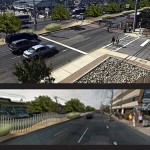OCEAN CITY — Resort officials got their first look this week at a proposed fencing alternative in the median along a section of Coastal Highway, and while they generally liked the option aesthetically, they voiced concern about the open fence’s ability to deter pedestrians from crossing mid-block.
The Ocean City Transportation Committee on Tuesday met with State Highway Administration (SHA) officials to discuss the proposed Pedestrian Safety and Connectivity Project for the median along Coastal Highway from Convention Center Drive to Route 90. The project includes enhanced lighting, bus lane adjustments and a physical barrier in the center of the median to deter pedestrians from crossing mid-block and encouraging them to use the marked intersections.

Renderings of the proposed median enhancements along Coastal Highway are pictured. Renderings by State Highway Administration
Historically, the section of the highway in the project area has produced the most pedestrian-vehicle collisions and SHA has been working with the town on developing a fence or other deterrent to prevent pedestrians from dashing across the highway. The plan is create an aesthetically pleasing barrier that also does not block the sight lines for motorists on both sides of the highway.
On Tuesday, SHA officials presented a proposed barrier that included five-foot high stainless steel posts set eight inches apart down the center of the median in the project area. The posts would not include any horizontal component to prevent would-be highway crossers from squeezing through. The posts appear to be undulated, and with increased landscaping and vegetation create an appearance of the dune fences so symbolic of Ocean City.
While Transportation Committee members were generally pleased with the aesthetic elements of the proposed barrier, they were less than thrilled with its apparent openness and voiced concern it would not deter many pedestrians from attempting to cross the highway mid-block.
“It needs to be connected,” said Mayor Rick Meehan. “With the eight-inch gaps, I think we need something horizontal or they will slip right through.”
OCPD Captain Kevin Kirstein agreed the project as proposed would not deter pedestrians from crossing at mid-block.
“Looking at this, I think pedestrians would challenge that, especially drunk pedestrians,” he said.
Meehan said the proposal accomplishes the town’s aesthetic goals for the barrier, but appeared to fall short on the safety side.
“We need to see a design for what we’re looking for and we need something horizontal,” he said. “If it’s open like that, they’re going to go right through it. I like the openness of it, but we need something they won’t wiggle through.”
Councilman Tony DeLuca, however, said he believed the proposed barrier accomplishes both goals.
“Aesthetically, it really looks good,” he said. “At five feet high and eight inches wide, I don’t think they’ll go through it.”
Kirstein said there were essentially two components to the proposed median barrier with one likely more important than the other.
“I’ve heard psychological and physical today,” he said. “Psychological is the big one. We don’t want them to even think they can try it.”
SHA officials said the median barrier as presented was conceptual, which is why it was being presented at the committee level. SHA Division Chief of Design Program Dennis German told the committee the design could be altered to include a horizontal component or scrapped in favor of something else entirely.
“We understand that and we want to do the best we can,” he said. “Either psychologically or physically, we’re not going to keep everybody from trying it. There will be some space if they get out there and realize they made a mistake.”
Town officials would like to see the overall project completed sooner rather than later. The design would ultimately have to be approved by the Mayor and Council after public meetings before finalizing the design and putting it out to bid. With the clock already ticking on the 2016 season, German said it would be a stretch to have by next summer.
“With the timeframe, 2017 is very doable, but 2016 would really be a push,” he said.
However, resort officials pressed SHA to get the project moving in time for next season and vowed to expedite its approval process if necessary.
“We like the hard push,” said Meehan. “We’re really looking at 2016. If we have to move the dates up, we’ll do whatever we have to.”
SHA Project Manager John Webster said a large part of the timetable was fabricating the steel posts, which would run every eight inches for roughly 20 blocks. Meehan asked if there was another type of barrier available in order to expedite the project schedule.
“Is there something that’s aesthetically pleasing but also available to cut down on the fabrication time and get this going faster?” he said. “That’s where I thought we would be today quite frankly. It looks great, but if it sets us back another year, we need to look at other options so we can move this project forward.”
SHA officials said they would explore altering the current proposal to include a horizontal element and would also look at some alternatives and get the information to the committee quickly in order to get the project in front of the full Mayor and Council early next year.
The median barrier is just one element of the proposed Pedestrian Safety and Connectivity Project. Also proposed are plans for added lighting in the center median including 36-foot high light poles every 200 feet with cobra-style fixtures attached to fully illuminate the median. Currently, Coastal Highway has 24-foot high light poles roughly every 200 feet down both sides of the highway but no lighting in the median. After some debate, the committee agreed it liked the median lighting concept, but questioned whether it would be more effective at 24 feet instead of 36 feet.
“The purpose of this is to light up that road,” said City Engineer Terry McGean. “In this case, I think the lower the better.”
Public Works Director Hal Adkins agreed and urged SHA to consider running the light poles along the whole length of the median in the project area.
“I think we need to position the light poles all the way down to the left turn lane stems,” he said. “We want to create an umbrella of light that is symmetrical down that whole length.”
In terms of the turn lanes, Councilman Dennis Dare said SHA should consider adjusting some of them during the project. At several intersections in town, vehicles lined up to make left turns back up into the travel lanes during the height of the season.
“I think we really need to revisit some of the turn lanes,” he said. “When they were designed, the town wasn’t nearly as developed as it is now and some of them are just too short for what it has become.”
Another element of the project is the proposed pinching of the bus and bike lane from 14 feet to 12 feet in order to facilitate the widening of the sidewalks in the project area. Similar changes were made in other areas along the highway to make them ADA compliant and Dare suggested the sidewalks should be widened in the project area to encourage pedestrians to cross at intersections.
“A five-foot sidewalk in Ocean City makes little sense,” he said. “If you want pedestrians to use the intersections, you have to make the sidewalks inviting. Down the road, instead of finding reasons not to widen the sidewalks, let’s look at ways to widen them.”

